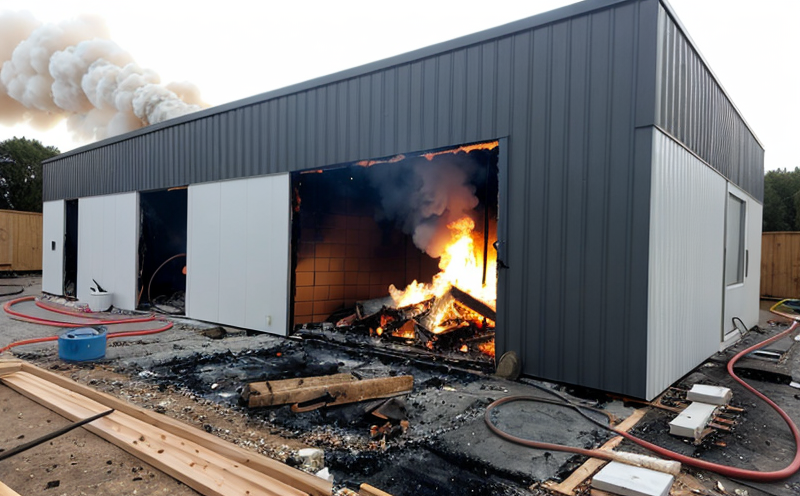Fire Endurance Testing of Stone Cladding
The fire endurance testing of stone cladding is a critical process in ensuring that building materials meet stringent safety standards and regulations. This service plays a pivotal role in the design, construction, and compliance of buildings, particularly those with exposed stone cladding systems. The purpose of this test is to evaluate how long a given specimen can resist fire before it sustains structural or functional damage.
The testing procedure involves subjecting stone cladding samples to controlled fire exposure conditions that simulate real-world scenarios. During the test, the sample is placed in an enclosed chamber where it is subjected to temperatures and durations that mimic the expected conditions of a building fire. The primary goal is to determine whether the stone cladding can maintain its structural integrity under these conditions.
This service is essential for architects, builders, and materials suppliers who want to ensure their products meet local and international standards such as ISO 834, EN 1363-5, and ASTM E119. By conducting this test, stakeholders can verify that the stone cladding they use will perform reliably in case of a fire, thereby enhancing public safety.
The specimen preparation for fire endurance testing involves selecting representative samples from batches or lots of stone cladding to be tested. These samples are then cut into standard sizes and shapes as per industry guidelines. The preparation process ensures that the specimens accurately represent the materials they will replace in actual construction projects.
Instrumentation used in this testing includes specialized chambers capable of simulating various fire environments, thermocouples for temperature measurement, and video cameras to monitor specimen behavior during testing. The data collected from these instruments is crucial for assessing the performance of the stone cladding under fire conditions.
The reporting process involves detailed documentation of all test parameters, including temperatures achieved, duration of exposure, and any observed changes in the sample’s structural integrity or appearance. Compliance with relevant standards is also documented to ensure that the tested materials meet required specifications.
Why It Matters
The fire endurance testing of stone cladding is not just a compliance exercise; it is a vital component in enhancing public safety and minimizing potential losses during fires. In areas prone to wildfires or other types of fires, the integrity of building materials like stone cladding can make all the difference between a contained blaze and an uncontrollable inferno.
The fire endurance test ensures that the stone cladding not only meets but exceeds the required standards set by regulatory bodies such as local fire codes, national building codes, ISO 834, EN 1363-5, ASTM E119, and others. Compliance with these standards is crucial for architects, builders, and materials suppliers to ensure their projects are safe and reliable.
By investing in this testing service, stakeholders can significantly reduce the risks associated with using substandard materials that may fail under fire conditions. This proactive approach not only protects lives but also safeguards property and reduces insurance costs. It is a testament to responsible construction practices that prioritize safety over mere compliance.
Applied Standards
| Standard | Description |
|---|---|
| ISO 834 | Methods of testing materials in building construction for resistance to fire. |
| EN 1363-5:2019 | Fire resistance tests of building materials and elements. |
| ASTM E119 | Standard test methods for fire tests of building materials and products. |
The standards mentioned above provide the framework for conducting fire endurance testing. They outline the specific procedures, conditions, and criteria that must be adhered to ensure accurate and reliable results. Compliance with these standards is essential to guarantee that the tested stone cladding meets the required safety levels.
Competitive Advantage and Market Impact
- Ensures compliance with international fire safety regulations.
- Enhances brand reputation through proven product quality.
- Reduces risks associated with non-compliant building materials.
- Promotes safer buildings that comply with local fire codes.
The ability to offer this testing service positions the laboratory as a leader in fire safety and compliance. It allows businesses to differentiate themselves from competitors by providing high-quality, safe products that meet stringent standards. This competitive advantage translates into enhanced market reputation and increased trust among clients and stakeholders.





